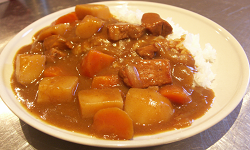Kare Raisu
 Gail Umehara / Wordsmith
Gail Umehara / Wordsmith
During her 16 years in Japan, Gail juggled raising a family with, amongst other things, working as a translation assistant, librarian, and editor. Back in Australia, she continues to work with words as an interpreter, editor and TAFE lecturer.
Kare Raisu
 If you ask Japanese schoolchildren about the origin of the kare raisu (curry rice) regularly served as school lunch, most will tell you it is a Japanese dish and in many ways they are right. Certainly, even though people around the world associate "curry" with India, not many people from India would recognize Japanese kare raisu as an Indian dish. In fact, the vindaloo, biryani, korma or other dishes we think of as variations of curry are considered separate dishes in Indian cuisine. The English word 'curry' is generally agreed to come from a Tamil word, kari, meaning spicy sauce; but British food writers Colleen and Peter Grove claim that the word goes all the way back to a 14th century Old English word 'cury' that simply meant 'cooking', which took on a more specific meaning centuries later when spices from the East found their way into English-style stew. From the colonies and through migration, curry, English-style, became popular throughout Britain in 2000, chicken curry was voted one of the top British national dishes in a Gallup poll.
If you ask Japanese schoolchildren about the origin of the kare raisu (curry rice) regularly served as school lunch, most will tell you it is a Japanese dish and in many ways they are right. Certainly, even though people around the world associate "curry" with India, not many people from India would recognize Japanese kare raisu as an Indian dish. In fact, the vindaloo, biryani, korma or other dishes we think of as variations of curry are considered separate dishes in Indian cuisine. The English word 'curry' is generally agreed to come from a Tamil word, kari, meaning spicy sauce; but British food writers Colleen and Peter Grove claim that the word goes all the way back to a 14th century Old English word 'cury' that simply meant 'cooking', which took on a more specific meaning centuries later when spices from the East found their way into English-style stew. From the colonies and through migration, curry, English-style, became popular throughout Britain in 2000, chicken curry was voted one of the top British national dishes in a Gallup poll.
And it was as a British dish that curry came to Japan around the 1870s. The Japanese Imperial Navy adopted the beef stew flavoured with curry powder that their Royal Navy counterparts were enjoying, with modifications the Royal Navy served curry with bread; Imperial Navy cooks substituted the bread with rice and thickened the dish with flour to keep it from spilling in high seas. In civilian society, raisukare was a luxury item at the Western-style restaurant Seiyoken in Ueno Park as early as 1877. But making curry at home did not become popular until the late 1950s, when blocks of curry paste, rather than powder, came on to the market. That made it easy to make curry anywhere, and the popularity of curry in Japan expanded to the point that it is estimated that on average a Japanese person now eats curry 84 times a year. The curry rice tradition is still maintained in the Japanese navy, where every Friday is "curry day" and different ships have their own special recipe several of which are published on the MSDF's website!
http://www.mod.go.jp/msdf/formal/family/recipe/archive/currey.html
